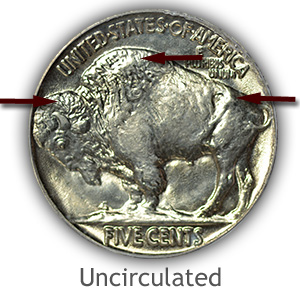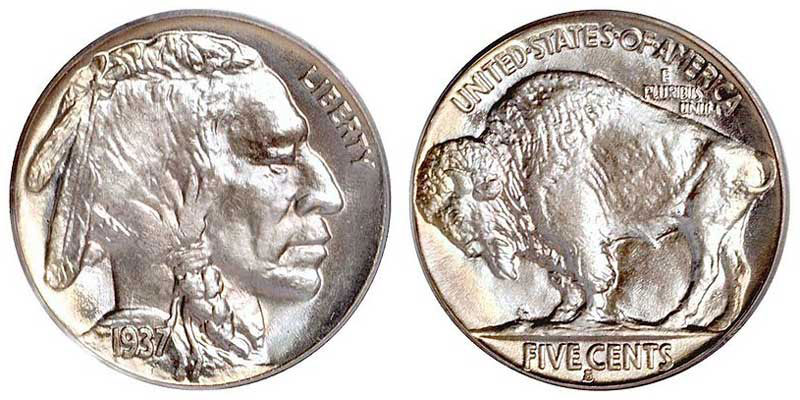
The Buffalo Nickel, or Indian Head Nickel, was introduced in 1913 and struck continuously until 1938. The series has been a long time favorite for coin collectors due to the uniquely American images featured on both the obverse and reverse designs. A set of circulated pieces can be completed with some persistence, however a full mint state set is a major accomplishment and a milestone for advanced collectors. Several interesting varieties such as the 1937-D Three Legged Buffalo Nickel add another aspect to collecting the series.

The Buffalo Nickel was the successor of the Liberty Nickel, which had been minted for circulation from 1883 to 1912. The new nickel was designed by James Earle Fraser, who initially produced a number of pattern pieces at his studio. One of these is now a famous pattern with the head of Abraham Lincoln on the obverse and a blank reverse. These are not products of the US Mint, but private patterns, correctly listed in Appendix C of the Judd book (United States Pattern Coins).
The design that was chosen as the new five cent denomination shows a Native American on the obverse. Fraser modeled the head of the Indian after three chiefs (Iron Tail of the Sioux, Two Moons of the Cheyenne, and John Big Tree of the Seneca nation) who had posed for him years earlier. The composite image was intended to represent a type, rather than an actual person. The inscription LIBERTY appears within the field on the right side of the coin, while the date appears on the truncation of the neck. Beneath the date is a small incused “F”, the designer’s initial. The placement of the date on a raised area of the design caused it to wear heavily in circulation, creating many “dateless” Buffalo Nickels.
The reverse design of the coin was produced in two distinct types. The original Type 1 design was produced for only a short time during the first year of issue in 1913, struck at all three mint facilities in use at the time. A male North American Bison, commonly called a buffalo, is standing on a raised mound. Although the Bison that Fraser used as model was never positively identified, legend has survived that it is Black Diamond from the New York Central Park Zoo. Beneath the mound is the denomination expressed as FIVE CENTS with the mint mark below. Above the Bison is the inscription UNITED STATES OF AMERICA with the motto E PLURIBUS UNUM slightly below.
Buffalo Nickels Worth
Soon after the first Buffalo Nickels were struck, it became apparent that area of the coin containing the denomination would wear quickly in circulation. The inscription had been placed on the highest point of the coin, which over time would have allowed it to wear away completely. Charles E. Barber, who had previously expressed strong criticism of the design, made some modifications. The revised or Type 2 design would have the overall relief lowered, the ground beneath the bison made flat, and the denomination placed within a recessed area to better protect it from wear. No modification was made to the placement of the date, which remained on a raised area of the design. This type, which was introduced part of the way through 1913, was used without further significant modifications until the end of the series.
Buffalo Nickel 1937


Buffalo Nickel Mn
- Indian Head or Buffalo Nickels (1913-1938) can be simple and affordable to collect for the intermediate coin collector, or challenging enough for the advanced coin collector. Buffalo nickel values range from just a few cents for common dates in well-circulated grades to thousands of dollars for key dates in pristine uncirculated condition.
- Find the current Buffalo Nickel values by year, coin varieties, and specific grade.
Buffalo Nickel Value No Date
US Buffalo Nickels (1913-1938) Buffalo nickels are a favorite of many coin collectors, partially because they are so easy to find. These coins, sometimes referred to as Indian head nickels, were minted between the years of 1913 and 1938.